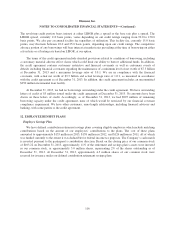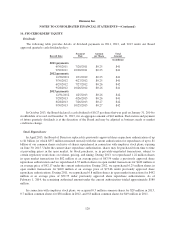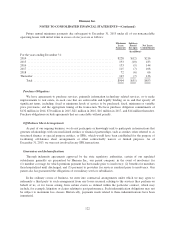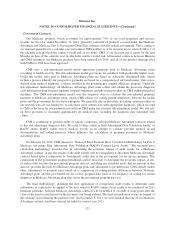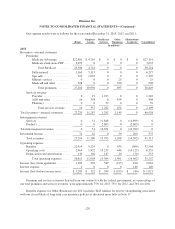Humana 2013 Annual Report Download - page 133
Download and view the complete annual report
Please find page 133 of the 2013 Humana annual report below. You can navigate through the pages in the report by either clicking on the pages listed below, or by using the keyword search tool below to find specific information within the annual report.Humana Inc.
NOTES TO CONSOLIDATED FINANCIAL STATEMENTS—(Continued)
Government Contracts
Our Medicare products, which accounted for approximately 74% of our total premiums and services
revenue for the year ended December 31, 2013, primarily consisted of products covered under the Medicare
Advantage and Medicare Part D Prescription Drug Plan contracts with the federal government. These contracts
are renewed generally for a calendar year term unless CMS notifies us of its decision not to renew by May 1 of
the calendar year in which the contract would end, or we notify CMS of our decision not to renew by the first
Monday in June of the calendar year in which the contract would end. All material contracts between Humana
and CMS relating to our Medicare products have been renewed for 2014, and all of our product offerings filed
with CMS for 2014 have been approved.
CMS uses a risk-adjustment model which apportions premiums paid to Medicare Advantage plans
according to health severity. The risk-adjustment model pays more for enrollees with predictably higher costs.
Under this model, rates paid to Medicare Advantage plans are based on actuarially determined bids, which
include a process whereby our prospective payments are based on a comparison of our beneficiaries’ risk scores,
derived from medical diagnoses, to those enrolled in the government’s original Medicare program. Under the
risk-adjustment methodology, all Medicare Advantage plans must collect and submit the necessary diagnosis
code information from hospital inpatient, hospital outpatient, and physician providers to CMS within prescribed
deadlines. The CMS risk-adjustment model uses the diagnosis data to calculate the risk-adjusted premium
payment to Medicare Advantage plans, which CMS adjusts for coding pattern differences between the health
plans and the government fee-for-service program. We generally rely on providers, including certain providers in
our network who are our employees, to code their claim submissions with appropriate diagnoses, which we send
to CMS as the basis for our payment received from CMS under the actuarial risk-adjustment model. We also rely
on these providers to document appropriately all medical data, including the diagnosis data submitted with
claims.
CMS is continuing to perform audits of various companies’ selected Medicare Advantage contracts related
to this risk adjustment diagnosis data. We refer to these audits as Risk-Adjustment Data Validation Audits, or
RADV audits. RADV audits review medical records in an attempt to validate provider medical record
documentation and coding practices which influence the calculation of premium payments to Medicare
Advantage plans.
On February 24, 2012, CMS released a “Notice of Final Payment Error Calculation Methodology for Part C
Medicare Advantage Risk Adjustment Data Validation (RADV) Contract-Level Audits.” The payment error
calculation methodology provides that, in calculating the economic impact of audit results for a Medicare
Advantage contract, if any, the results of the audit sample will be extrapolated to the entire Medicare Advantage
contract based upon a comparison to “benchmark” audit data in the government fee-for-service program. This
comparison to the government program benchmark audit is necessary to determine the economic impact, if any,
of audit results because the government program data set, including any attendant errors that are present in that
data set, provides the basis for Medicare Advantage plans risk adjustment to payment rates. CMS already makes
other adjustments to payment rates based on a comparison of coding pattern differences between Medicare
Advantage plans and the government fee-for-service program data (such as for frequency of coding for certain
diagnoses in Medicare Advantage plan data versus the government program data set).
The final methodology, including the first application of extrapolated audit results to determine audit
settlements, is expected to be applied to the next round of RADV contract level audits to be conducted on 2011
premium payments. Selected Medicare Advantage contracts will be notified of an audit at some point after the
close of the final reconciliation for the payment year being audited. The final reconciliation occurs in August of
the calendar year following the payment year. On November 5, 2013, we were notified that one of our Medicare
Advantage contracts had been selected for audit for contract year 2011.
123





